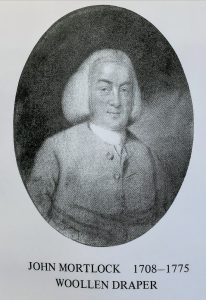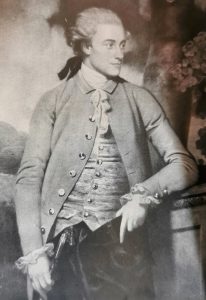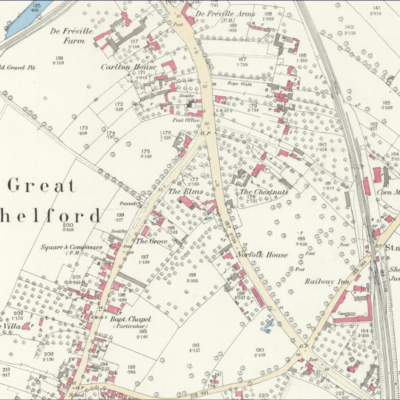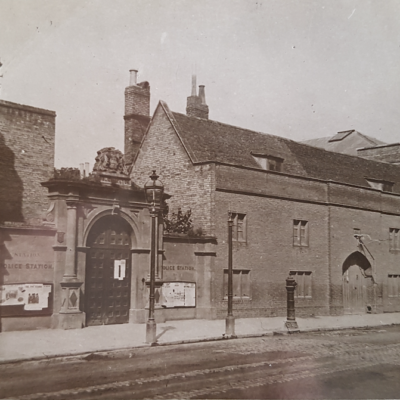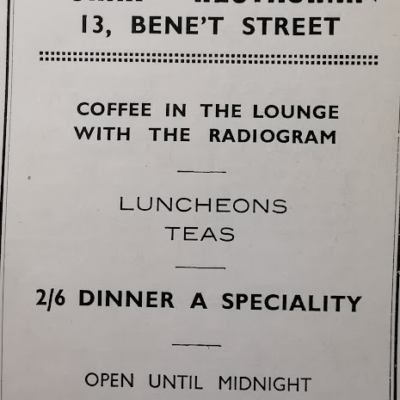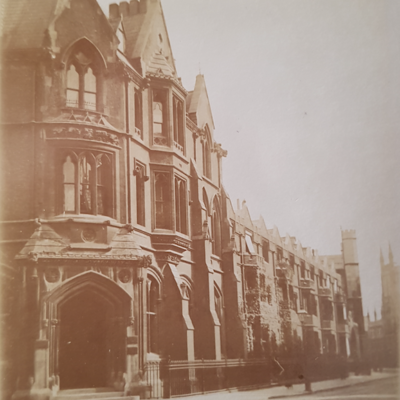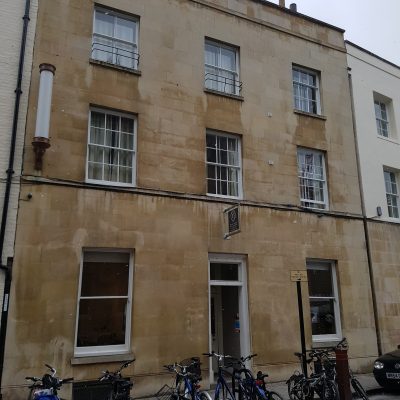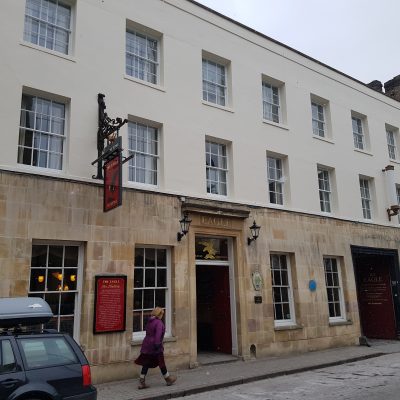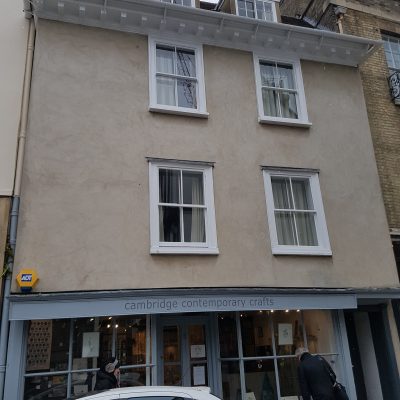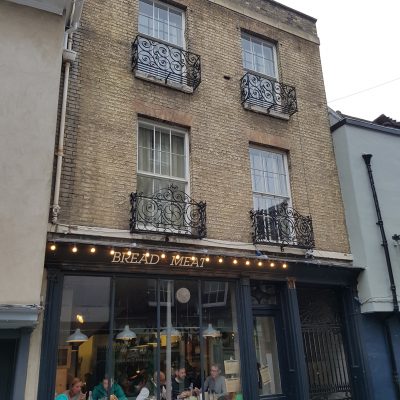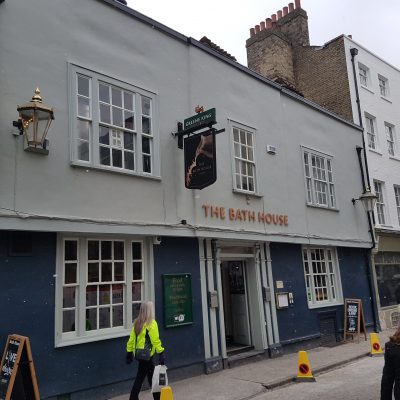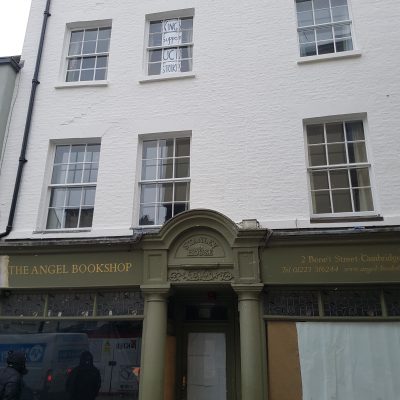Search by topic
- archaeology
- Building of Local Interest
- chapel
- charity
- church
- crime
- dressmaker
- Great Eastern Railway
- Listed building
- Mapping Relief
- medieval
- oral history
- poverty
- Public House
- Rattee & Kett
- Religious House
- Roman
- scholar
- school
- Then and Now
- tudor
- women
- work
- world war one
- world war two
Search by text
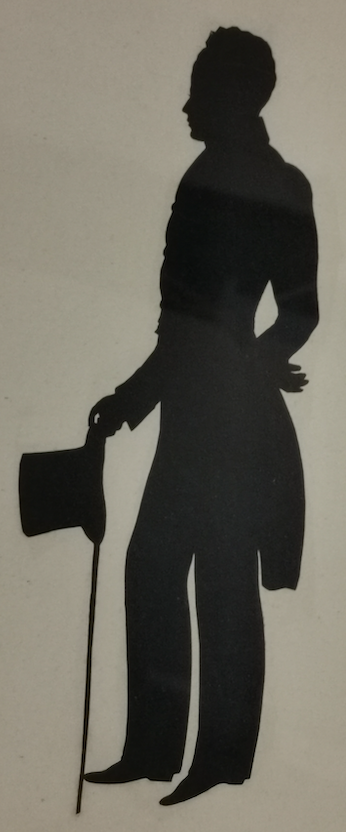 John Frederick Mortlock
John Frederick Mortlock14, 15, 16 Bene’t Street
History of 14-16 Bene't Street
According to 1959 Royal Commission on Historical Monuments Survey of Cambridge, Barclay’s Bank, facing Peas Hill, is of three storeys. The site, on which stood the gateway of the Augustinian friary, was bought by William Finch, ironmonger, in 1720 who built a house and outbuildings where he lived until his death in 1761.
In 1783 the house was bought by John Mortlock and in 1786 it was part the private house and part the bank of E J Mortlock. The outbuilding were demolished when the Arts Schools were built. During the second half of the 19th century the two lower floors of most of the house were remodelled to form a lofty banking hall. Some of the rooms of the second floor retain 18th cent. features. The room in the SE wing was formerly Mortlock’s dining room and was decorated circa 1790.
Many of the fittings removed from here in 1896 were installed in ‘Thorneycreek‘ Herschel Road.
A very detailed account of the John Frederick Mortlock story can be found in ‘Cambridge to Botany Bay‘, A E Clark-Kennedy, 1983.
John Mortlock b.1708 had bought property in Cambridge. His son John b.1756 had married an heiress, Elizabeth Harrison, daughter of a wealthy presbyterian grocer. As well as carrying on the family business he started to engage in money transactions for which at that time it was difficult to find an agent. A reliable agent was important to prevent cash, stock etc falling into the hands of highwaymen. He eventually bought the old house of the Austin Friars in Bene’t Street to conduct this new business at. In so doing John Mortlock moved from draper to banker.
John Mortlock continued to gain political powerful, first through election as an alderman. He also joined the camp of the Duke of Rutland who was looking to gain parliamentary seats. Mortlock started a new alderman’s club at the Eagle, opposite his bank, to promote Rutland’s ambitions. This whetted Mortlock’s own ambition even more and he was elected as member for the city of Cambridge.
When it came to the choice of which of his son’s was to carry on the family business, John made the mistake of selecting his fourth son, Frederick Cheetham, who had no real qualifications for the role. He had neither academic skills nor business experience. Then, Frederick eloped with Sarah Finch, “the beautiful daughter of a respectable gentleman in Shelford.” Frederick was to become a partner in his father’s bank but proved himself incompetent. His brother Thomas took over the bank and herein lies the root of the problem that took over Frederick’s son’s life – John Frederick, who was transported to Australia – twice.
Prof Helen Maud Cam on the ‘Corruptocracy’ of John Mortlock’s Cambridge in early 1800s
The following is an extract from the Australian website Convict Records:
The founder of what could be regarded as the Mortlock dynasty was John Mortlock. He was born in Cambridge in 1756, the son of a fairly well to do draper. The family also owned flocks of sheep which grazed in Pampisford, whose wool was turned into clothes as part of the family business. It seems that John was very much an entrepreneur and in his twenties was lending money and issuing promissory notes to merchants travelling to Cambridge by coach, thus reducing the need to carry large amounts of cash which could be stolen by highwayman. This led to him founding a banking business which soon became the most prominent in Cambridge. His bank flourished at the Bene’t Street site until 1896 when it was bought by Barclays. The blue wall plaque for John Mortlock has an intriguing quotation: “That which you call corruption I call influence”. This would seem to indicate that he was less than scrupulous in his business dealings. This was probably how he managed to become elected as an MP for Cambridge while also holding the job “Collector of Land Taxes for Cambridge”. He was later forced to resign as MP, but this did not seem to prevent him from having been an MP no less than 13 times.
Perhaps because of his questionable business ethics he apparently was not the most popular man in Cambridge during his early banking career and invested some of his cash by “buying to let” Abington Hall in 1780, which he rented out to wealthy tenants.
He married Elizabeth Harrison, who was the daughter of a wealthy Cambridge grocer and together they had 9 children, the seven eldest being sons, two of whom also became MPs after John’s death in 1816.
After his death most of the family business and properties was administered by Charles, the 3rd son who bought the 4th son, Frederick Cheetham’s share. One of the other prominent sons was Edmund, who was a clergyman and a Cambridge academic. The son who appeared to do most to continue the line however was Frederick Cheetham. He married another local girl, Sarah Finch, and they had seven children. The eldest of the sons, John Frederick, born 1809, after his father’s death in 1838 had a vendetta against his 2 uncles, Charles and Edmund, who he felt had cheated him of his share of the estate left by Frederick. He initially picketed the Bene’t Street bank using an apple stall to block the pavement and giving out pamphlets. By all accounts this became quite a spectacle.
The stall and tent had a large inscription:
Apple Stall kept by Mr Mortlock
Nephew of Messrs Mortlock, bankers, and of the Right reverend the Lord Bishop of Lincoln
John Frederick spent the day seated in this tent clad in a magnificent velvet lined coat, books on the table before him and a silver salver for donations at his side. Donations did pour in and friends took turns to sit in the tent with him. Whenever Thomas Mortlock, his uncle, appeared at the door of the bank, he was ridiculed.
This vendetta culminated in an apparent arson attack on Rectory Farm in Pampisford, owned by the Mortlocks, and later another fire at Thomas Mortlock’s house in Great Abington (Abington Lodge) in 1837. John was tried for this on the basis of reports of him being seen in the vicinity at the time, but he was acquitted on the grounds of insufficient evidence. He obviously was able to afford a good lawyer! His final act of retribution, in November 1842, was to assault Edmund while he was in his Christ College rooms. A shot was fired, injuring Edmund. So John was arrested, tried, and sentenced to 25 years deportation to Australia. By all accounts his adventures did not end there and he continued to have various misadventures for many years.
John Frederick Mortlock was a highly educated man. He was about 35 years old when he arrived at Norfolk Island and was engaged as a tutor to the young son of Mr Gilbert Robertson, the Agricultural Superintendent and Deputy Commandant.
See:
J F Mortlock – Experiences of a Convict by G A Wilkes and A G Mitchell, 1864.
1851
(unnumbered)
Thomas Mortlock, 71, banker, b Cambridge
Mary Hymes, housekeeper, 47, b West Wratting
Eliza Blencowe, 28, servant,
Edith Ellis, 23, servant, b Little Abington
William Aldridge, 25, butler, b Suffolk
Payne Rodwell, 23, groom, b Little Swaffham
(unnumbered)
John Eaton, 58, banker, b Newmarket
Ann, 69, b Swaffham
Ann, 28, b Cambridge
Elizabeth Glover, 34, servant, b Comberton
Elizabeth Stanford, 16, servant, b Teversham
Joshua Kirby Balchy, 49, bankers clerk, b Cambridge
(14)
John Lee, 53, wine merchant, b Cambridge
1874
(14) Graves and Waters, wine and spirit merchants
1891
(15)
William Looker, 51, banker’s clerk, b Herts
Mary A, 51, b Cambridge
Arthur G, 22, banker’s clerk, b Cambridge
Harriet, 21, milliner, b Cambridge
William, 19, student and museum assistant, b Cambridge
Edith M, 15, milliner, b Cambridge
Ruth L, 12, b Cambridge
Frances, 7, b Cambridge
Alice Stonebridge, 17, servant, b Madingley
Susan Mayes, 16, servant, b Essex
In 1901 Arthur G is living at 96 Victoria Road
1917
Barclay’s acquired the bank after it had passed into the hands of Dr Edmund Parker, a member of Francis and Co, solicitors.
1962
14 Barclays Bank
15-16 Barclays Bank
15-16 A E Bowers
Contribute
Do you have any information about the people or places in this article? If so, then please let us know using the Contact page or by emailing capturingcambridge@
License
This work is licensed under CC BY-NC-SA 4.0





